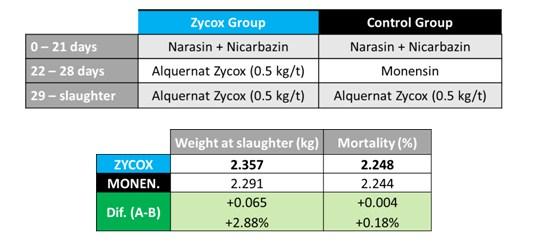Coccidiosis in South East Asia and its succesful control
Published: February 2, 2021
By: Maria Soriano
WHAT IS COCCIDIOSIS?
Coccidiosis is the main parasitosis of poultry in South East Asia. Weather and farm conditions, management practices, together with the high prevalence of vectors in the region, such as Alphitobius, ease the survival and development of coccidia.
Coccidiosis is a disease present in the poultry industry worldwide affecting the intestine and therefore, the growth and performance of birds. It is caused by protozoa of the genus Eimeria. The multiplication of this parasite damages the intestinal tissue, causing poor nutrient absorption, diarrhea of different degrees, possible dehydration, and death.
WHAT ARE THE COMMON EIMERIA SPECIES IN SOUTH EAST ASIA?
There are seven species colonizing the intestinal tract of chickens: E. acervulina, E. maxima, E. tenella, E. mitis, E. necatrix, E. praecox, and E. brunetti. Each species has a specific location in the intestine and produces lesions of different severity.
Eimeria tenella is the most prevalent species in Asia and causes haemorrhagic typhlitis, a severe lesion leading to high mortality. Simultaneous infestation by several species of Eimeriais common and E. necatrixis the most frequent species in mixed infections. In addition, lesions caused by E. maxima are a gateway to other infections, like necrotic enteritis.
HOW MUCH DOES COCCIDIOSIS IMPAIR THE SUCCESS OF THE FARM?
Coccidiosis is one of the most important diseases in South East Asia because of its consequences on production, causing growth stunt and poor feed conversion, decrease in production and mortality in broilers, cage-free pullets, and breeders. In addition, there are economic losses linked to its prevention and control, and the negative effects of secondary infections, such as necrotic enteritis.
Coccidiosis is one of the costliest diseases in poultry, as it is estimated to cost over 2 billion dollars to the poultry industry worldwide.
HOW HAS COCCIDIOSIS BEEN CONTROLLED IN SOUTH EAST ASIA?
Productivity of the farm depends on a proper control of diseases. Prevention and control of coccidiosis in South East Asia is usually done by combining coccidiostats with biosecurity, cleaning, disinfection, and management measures.
Coccidiostats are classified into synthetic or chemical coccidiostats, such as nicarbazin, or ionophore coccidiostats, such as monensin or maduramycin.It is common to carry out rotation or shuttle programs, where ionophores are widely used and sometimes combined with synthetic anticoccidials.
The continued and abusive use of coccidiostats has led to the development of resistances in South East Asia. Moreover, regulations and consumer trends are shifting to the reduction on the use of drugs in animals intended for human consumption. These considerations fasten the need for other strategies to prevent coccidiosis that do not create resistances while maintaining performance. Such strategies are based on immunological control of the disease, like vaccines and natural feed additives.
IMMUNOLOGICAL CONTROL OF COCCIDIOSIS
COCCIDIOSIS VACCINES
Vaccination in Asia is done through non-attenuated coccidiosis vaccines.It is more widespread in broiler breeders than in broilers due to their price, although they are gaining importance in free-cage broilers and antibiotic-free production. Animals are usually vaccinated at hatchery or at the first day of life.
Results obtained are quite encouraging, but they have several limitations:
- Animals are protected against the Eimeria strains present in the vaccine. If the field strain is different, birds will be infected despite the use of the vaccine.
- Vaccines may cause mild infestation and cause growth retardation at first stages, which might not be compensated before slaughter time in broilers.
- Broilers raised up to 60 days can suffer from late-cycling coccidiosis despite vaccination.
NATURAL SOLUTIONS: ALQUERNAT ZYCOX
A natural dietary supplement, called Alquernat Zycox, based on intestinal optimizer pronutrients, aims to improve the gut immunity and, in turn, the performance of the animals. This natural additive is a promising strategy available in South East Asia which is gaining importance in the region.
Intestinal optimizer pronutrients are molecules of plant origin with a metagenetic mechanism of action, described by the R&D department of Biovet. They target the immune cells of the digestive tract (local immune system) and act as a stimulus, enhancing the reading of certain genes aiming to improve the immune response of the animals against parasitic invasions like coccidia.
In this way, when coccidia get into the digestive tract, animal’s immune cells rapidly eliminate the parasite, preventing them from finishing the reproductive cycle and damaging the digestive mucosa. A better protection against coccidiosis will have a positive impact on performance.

Intestinal optimizer pronutrients in Alquernat Zycox stimulate the synthesis of interleukins (IL-1, IL-12, IL-18) by intestinal polymorphonuclear cells (PMNs). Interleukins act as chemical mediators and attract defence cells to the affected area, playing a fundamental role in the response to coccidiosis.
WHICH ARE THE ADVANTAGES OF ALQUERNAT ZYCOX?
The advantages of Alquernat Zycox, thanks to its mechanism of action, are that:
- No resistances can be developed (long-term efficacy, even administered in successive production cycles because the target is not the parasite, it is the physiologic stimulation of the immunity).
- It is effective against all Eimeria strains (no selective immunity, physiologic stimulation ensures any protozoa will be eliminated).
- No withdrawal period is required, as no residues are left in tissues.
Alquernat Zycox is the unique natural product for the prevention of coccidiosis with a patented technology and proven mechanism of action described with molecular (in vitro) trials and proven efficacy through field (in vivo) trials conducted following the scientific methodology.
Additionally, Alquernat Zycox is available in premix powder, intended to be mixed with feed, and liquid presentation, to be included in the drinking water, and can be used in conventional, antibiotic-free and organic (ECO certified) Production systems.
CAN ALQUERNAT ZYCOX BE COMBINED WITH OTHER PREVENTION METHODS?
Alquernat Zycox is effective to be used as the only prevention method against coccidiosis, although it also offers a great versatility to be included in the anticoccidial plan of the farm, as it can be combined with coccidiostats (whether ionophores or chemicals) and coccidiosis vaccines. These affirmations are corroborated by the multiple trials performed, some of them described next:
- ALQUERNAT ZYCOX – PARTIAL REPLACEMENT OF COCCIDIOSTATS
Alquernat Zycox is a great tool to reduce the use of anticoccidial drugs since it allows a total or partial replacement of coccidiostats present in shuttle or rotation programs.
For instance, Alquernat Zycox is a safe bet to replace monensin, as it obtained better weight and mortality rate in a trial made with 144,000 broilers.

- ALQUERNAT ZYCOX USED ON TOP OF COCCIDIOSTATS
Alquernat Zycox can be combined (used ON TOP) with coccidiostats during high challenge periods to control mortality and reduce the negative effects in performance.
When Alquernat Zycox was administered during 13 days (from day 8 till day 21) in 730,000 broilers, located in tropical climate, combined with coccidiostats, it reduced mortality by 40% and feed conversion rate (FCR) by 4% compared to the group receiving only coccidiostats.
- ALQUERNAT ZYCOX COMBINED WITH VACCINATION
Alquernat Zycox can also complement vaccination. When used in combination with vaccines, it boosts the immunity achieved by the vaccines (synergistic effect) and a better protection against coccidiosis is accomplished, especially in the peak of the outbreak, a critical moment of the productive cycle as there is a greater challenge.
Alquernat Zycox used from day 15 till slaughter combined with vaccination in 600 broilers achieved a 34% lower mortality related to coccidia and 20% lower oocysts per gram of faeces (OPG) at the peak of the cycle (28 days) compared to group with only vaccination.
CONCLUSIONS
Coccidiosis prevention has been based on the use of coccidiostats, which are becoming obsolete because of the development of resistances and loss of efficacy and the change in consumer trends and regulations. The current situation makes producers increase the use of natural solutions.
Alquernat Zycox, based on intestinal optimizer pronutrients, is a promising strategy with a patented technology that can be used alone or combined with vaccines (34% mortality reduction) and coccidiostats in farms facing hard coccidiosis challenges (proved replacement of monensin, 40% reduction of mortality and 4% in the FCR when combined with coccidiostats).
The great versatility of this unique natural solution is complemented with other advantages, as no resistances can appear and no withdrawal period is required, it can be used in different production systems (conventional, antibiotic-free, organic), and it is available both in powder and liquid forms.
Related topics:
Authors:
Biovet-Alquermes
Recommend
Comment
Share
18 de febrero de 2021
Coccidiosis is common in commercial broiler and some time broiler and predisposing factor necrotic interties in Bangladesh. Coccidiostats use in commercial broiler and vaccine use in breeder. Due to the poor management Coccidiosis also occur after use of coccidiostats and vaccine.
Recommend
Reply

Would you like to discuss another topic? Create a new post to engage with experts in the community.









.jpg&w=3840&q=75)